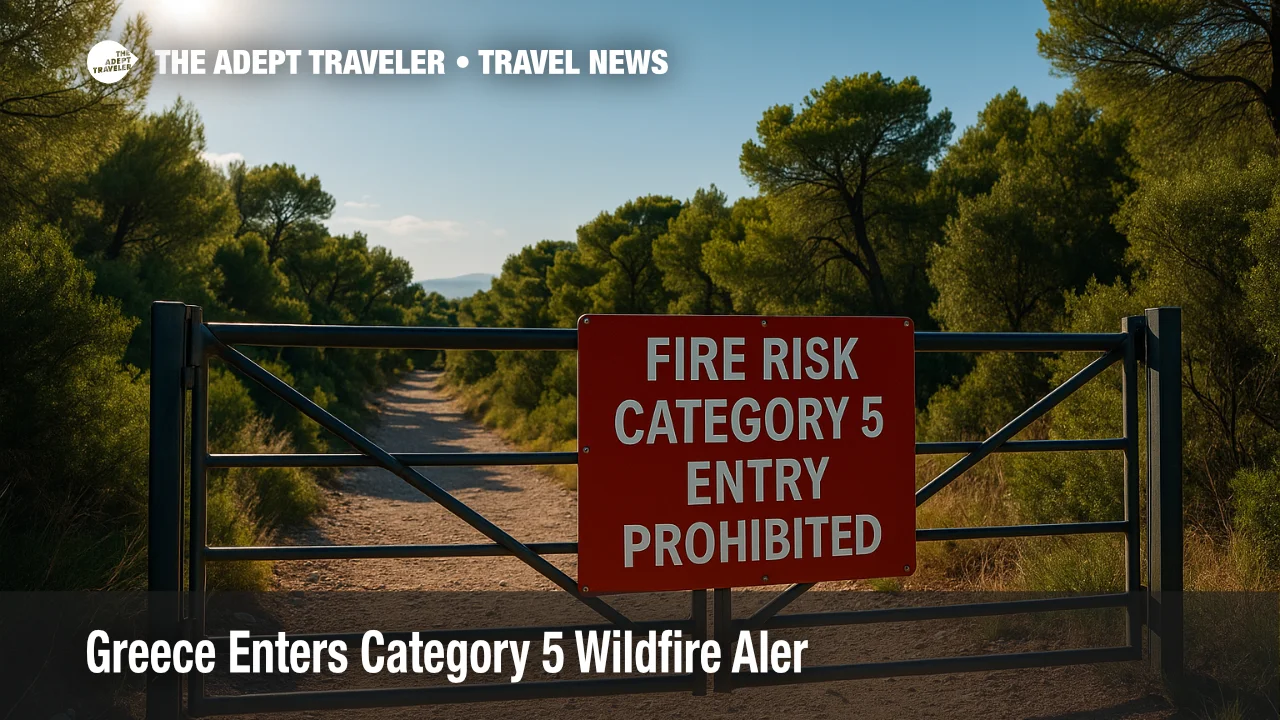Greece Enters Category 5 Wildfire Alert

Greece has placed Attica, much of the Peloponnese, southern Evia, and nearby islands under the nation's highest Category 5 wildfire alert through Sunday. Temperatures near 109 °F and gusty northerly winds are expected to create explosive fire conditions, prompting bans on forest access, trail closures, and midday shutdowns of marquee sites such as the Acropolis. Travelers should monitor 112 mobile alerts, allow extra time for detours, and check venue hours before departing.
Key Points
- Why it matters: Category 5 signals "State of Alert," meaning any spark can escalate in minutes.
- Affected areas: Attica (including Kythira), Corinthia, Argolida, Arkadia, Messinia, Laconia, Boeotia, and southern Evia.
- Vehicle, hiking, and barbecue bans now cover national parks and coastal pine belts.
- Athens' Acropolis, Lykavittos Hill, and several Peloponnese antiquities will close 12 p.m.-5 p.m. to protect visitors from heat and smoke.
- Civil Protection has pre-deployed air tankers and issued SMS evacuation templates for 112 alerts.
Snapshot
Hot, dry northerlies-forecast at 25 mph over the Saronic Gulf-will combine with 109 °F ground temperatures to push Greece's Fire Risk Map into its red "Category 5" zone for the first back-to-back weekend of 2025. Authorities have ordered 24-hour patrols around Mount Parnitha, Sounion National Park, and the Taygetus highlands, where dense conifer stands can erupt quickly. Travelers will see roadblocks on forest approaches, while concessionaires inside affected parks have been told to suspend operations. Ferry and flight schedules remain normal, yet Civil Protection warns that reroutes or aerial water-drop priorities could lead to short-notice air-traffic holds.
Background
Greece's wildfire season has lengthened by nearly a month over the past decade, according to the National Observatory of Athens, driven by prolonged heatwaves and diminished soil moisture. This week's dome of Saharan air pushed inland highs above 111 °F and kept nighttime lows near 86 °F, depriving vegetation of recovery time. The country's Category 5 protocol-activated only when temperature, wind, and fuel aridity indices align-triggers automatic bans on open-flame work, logging, and agricultural burning. It also empowers regional governors to close archeological parks and scenic viewpoints when Wet-Bulb Globe Temperature exceeds 90 °F, as is forecast for central Athens.
Latest Developments
Parks & Sites Closed Noon-5 p.m.
The Culture Ministry confirmed that the Acropolis, Ancient Agora, and Temple of Poseidon will shut during peak heat, while forested hills such as Lykavittos and Philopappou are off-limits around the clock. In the Peloponnese, visitor centers at Ancient Olympia and Mycenae will operate shortened morning hours only.
Civil Protection Mobilization
A fleet of 22 Canadair and Erickson sky-cranes is now staged at Tatoi, Kalamata, and Andravida air bases, ready for rapid response. Ground crews from northern prefectures are rotating south to reinforce Attica and Argolida, and volunteer brigades have been placed on 12-hour standby. The 112 system tested its new English-language alert push Friday night, assuring tourists they will receive evacuation orders simultaneously with residents.
Advice for Travelers
Stay within urban grids after midday, carry at least two liters of water per person, and program 199 (Fire Service) and 112 into your phone. Rental-car agencies advise parking only on paved lots; catalytic converters can ignite dry grass. Cruise and ferry passengers transiting Piraeus should confirm post-tour meeting points twice, as buses may reroute to avoid wooded slopes above the port.
Analysis
This Category 5 alert illustrates how climate-driven extremes are reshaping Mediterranean travel patterns. Greece has refined its emergency playbook since the lethal 2018 Mati fire, yet the country's tourism economy still clusters around coastal pine zones and classical monuments that double as heat traps. Closing heritage sites during midday not only safeguards visitors but also reduces ignition sources from foot traffic and disposable lighters. The bigger concern is that repeated closures-already four days this month-could dampen last-minute booking demand during Greece's critical August peak. Airlines and tour operators have learned to pivot quickly, offering dawn or evening excursions and touting cooler island microclimates such as Hydra or Syros. For U.S. travelers, the takeaway is preparedness: flexible itineraries, travel-insurance clauses covering natural-hazard disruptions, and heed for local instructions. As heatwaves lengthen, the civil-protection SMS network and early-site-entry strategies (arriving before 10 a.m.) will become routine parts of Greek vacation planning.
Final Thoughts
Greece's rare back-to-back Category 5 alert underscores a new wildfire normal. Stay alert, respect closures, and adjust daytime plans; the ruins and beaches will still be there once the immediate danger passes, but safety during a Category 5 wildfire risk is paramount.
Sources
* Firefighters on high alert as extreme wildfire risk looms * Civil Protection Fire Risk Map - valid for July 27 2025 * Greece Warning! Extreme Fire Risk & Very High Risk, July 26 * Athens Monuments Closed to Public During Heatwave Peak * Heatwave to continue Saturday with 44°C in some areas
